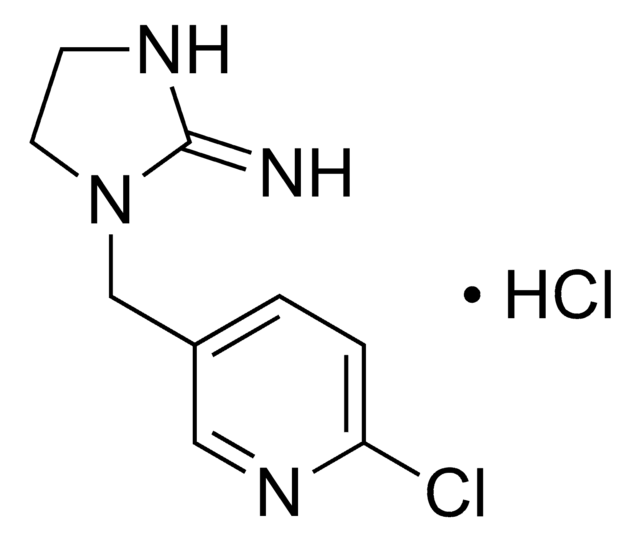33897
Thiacloprid-amide
PESTANAL®, analytical standard
Synonym(s):
[3-(6-Chloro-3-pyridylmethyl)thiazolidin-2-ylidene]urea
About This Item
Recommended Products
grade
analytical standard
Quality Level
product line
PESTANAL®
shelf life
limited shelf life, expiry date on the label
technique(s)
HPLC: suitable
gas chromatography (GC): suitable
application(s)
agriculture
environmental
format
neat
SMILES string
NC(=O)\N=C1/SCCN1Cc2ccc(Cl)nc2
InChI
1S/C10H11ClN4OS/c11-8-2-1-7(5-13-8)6-15-3-4-17-10(15)14-9(12)16/h1-2,5H,3-4,6H2,(H2,12,16)/b14-10-
InChI key
LEZHOZPJYAQQNU-UVTDQMKNSA-N
General description
Find more information here: Neonicotinoids
Application
- Green pepper/tomato samples using water based extraction and solid-phase extraction followed by liquid chromatography coupled to tandem mass spectrometry (LC-MS/MS).[2]
- Honey bees and honey samples using solid-phase extraction followed by liquid chromatography coupled to tandem mass spectrometry (LC-MS/MS).[3]
Recommended products
Legal Information
Storage Class
11 - Combustible Solids
wgk_germany
WGK 3
flash_point_f
Not applicable
flash_point_c
Not applicable
ppe
Eyeshields, Gloves, type N95 (US)
Choose from one of the most recent versions:
Certificates of Analysis (COA)
Don't see the Right Version?
If you require a particular version, you can look up a specific certificate by the Lot or Batch number.
Already Own This Product?
Find documentation for the products that you have recently purchased in the Document Library.
Protocols
Learn more about Neonicotinoids - active substances used in plant protection products to control harmful insects.
Analysis of banned neonicotinoid insecticides from dandelion blossoms using QuEChERS and LC-MS.
Active Filters
Our team of scientists has experience in all areas of research including Life Science, Material Science, Chemical Synthesis, Chromatography, Analytical and many others.
Contact Technical Service








